Search
Did you mean: Byzantium?
Search Results
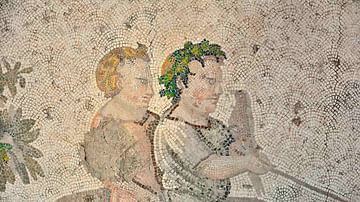
Image
Byzantine Mosaic of Children Seated on a Dromedary
Two children are seated on a dromedary. One of them wears a wreath around his head and is holding a bird in one hand and reins with the other hand. There is also a guide in front of them. Period: Early Byzantine, c. 6th century CE. Place...
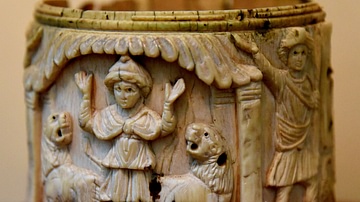
Image
Byzantine Ivory Pyxis
This pyxis once had a lockable lid and was perhaps used to hold sacramental bread. Its carvings refer to the Biblical tale of Daniel in the lions' den. Byzantine, 5th or early 6th century CE. From modern-day Egypt or Syria. (The British Museum...
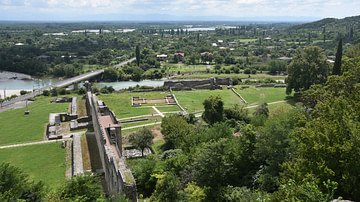
Image
Byzantine Fortress of Archaeopolis (Nokalakevi), Georgia
Archaeopolis is a Byzantine city-fortress in ancient Lazica (Colchis) in modern-day western Georgia commanding the junction of the River Tekhuri and a strategic route to the north. Archaeopolis played a pivotal part in the 6th-century CE...
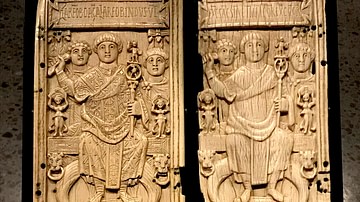
Image
Byzantine Diptych of Ivory
Diptych (two-part writing tablet), ivory. c. 506 CE. From the collection of the Zurich historian J. H. Hottinger (1620-1667 CE). The man on the throne was called Areobindus. He is shown giving the signal to begin the animal combat depicted...
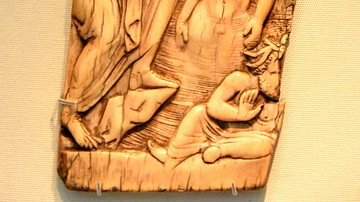
Image
Byzantine Ivory Panel Depicting the Baptisim
A figure of the young Christ stands full-face up to the waist in water. To the left, St. John, the Baptist, stands and leans forward upon a rock. One of his hands rests upon Christ's head. At the upper part of the panel, the hand of God appears...

Image
Byzantine Marriage Ring
This Byzantine gold marriage ring dates to the 3rd to 4th centuries CE. The ring measures 56 mm in circumference and the bezel measures 10x10 mm. Weight: 4.5 grams. (Metropolitan Museum, New York)
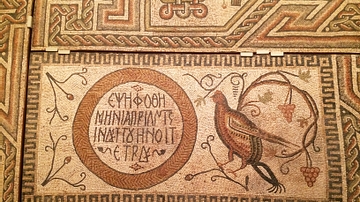
Image
Byzantine Floor Mosaic from Eastern Mediterranean
This exceptional mosaic likely comes from the floor of a house or public building. It reflects the Late Romand and Early Byzantine taste for intricate and colorful designs. It dates from c. 325-350 CE and is made of limestone tesserae. The...
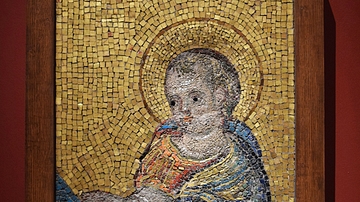
Image
Byzantine Mosaic of Christ Child
This mosaic of Jesus Christ as a child is rendered in Byzantine style and made by Jacopo Torriti (or "Turriti"). Torriti was an Italian painter and mosaic-maker during the late 13th century CE. He lived and worked in Rome, Italy. (Pushkin...
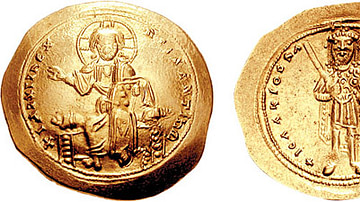
Image
Byzantine Histamenon of Isaac I
Gold histamenon coin of Byzantine emperor Isaac I Komnenos (r. 1057-1059 CE), who is pictured on the reverse (on the right), crowned and in military dress, while the obverse shows Christ enthroned. (Classical Numismatic Group, Inc. http://www.cngcoins.com...
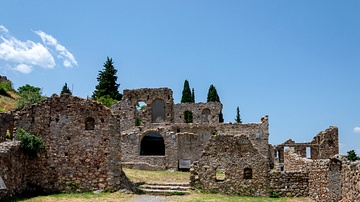
Image
Byzantine Castle of Mystras
Byzantine castle of Mystras, Greece. Mystras was the capital of the Despotate of the Morea. The castle was built by William II of Villehardouin, Prince of Achaea (r. 1246-1278 CE).